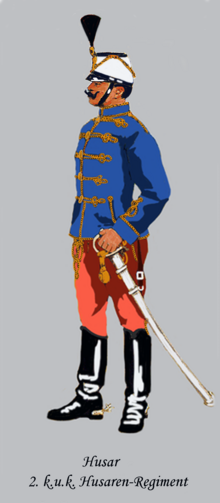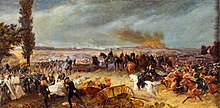Imperial and Royal Hussar Regiment "Friedrich Leopold of Prussia" No. 2
The hussar regiment "Friedrich Leopold of Prussia" No. 2 was set up as the Austro-Habsburg cavalry association. The unit existed afterwards in the kk or common army within the Austro-Hungarian land forces until the end of the First World War.
When a cavalry ranking was drawn up in 1769, the association was given the name Cavalry Regiment No. 17 .
All honorary names of the regiments were deleted without replacement in 1915. From then on the regiment was only to be called "Hussar Regiment No. 2". (However, this could not be implemented in practice, on the one hand because no one adhered to it, on the other hand because the very thrifty Austro-Hungarian military administration had ordered that all remaining forms and stamps be used up first!)
Lineup
The application of the Estates of Transylvania to the emperor for the establishment of a hussar regiment was granted on April 17, 1742, and the establishment of the Transylvanian hussar regiment was ordered on the same date by the highest resolution . As was customary at the time, however, a short time later it was only named after its owner.
additions
Until 1875, the regiment was made up exclusively of the Transylvanian landscape. Then the supplementary district was expanded and extended to the neighboring districts of Hungary and the Banat . In 1889 the Sibiu district was assigned.
Peace garrisons
| I. | II. | III. |
|---|---|---|
|
|
Regimental owner
- 1749 Sergeant General Anton Graf Kálnoky (Hussar Regiment Kálnoky)
- 1762 Jazygier Hussar Regiment
- 1798 (new name: Hussar Regiment No. 2)
- 1784 Colonel Archduke Leopold Alexander , Palatine of Hungary
- 1795 General of the Cavalry Archduke Joseph Anton , Palatine of Hungary
- 1847 Ernst August , King of Hanover
- 1852 Nicholas , Grand Duke of Russia
- 1893 Friedrich Leopold , Prince of Prussia
Second owner
- 1784 Major General Michael Baron Splényi von Miháldy
- 1840 Field Marshal Lieutenant Ferdinand Graf Zichy
- 1809 Lieutenant Field Marshal Daniel Freiherr von Mecséry
- Unoccupied in 1823
- 1825 General of the cavalry Ignáz Freiherr Splényi von Miháldy
- 1849 Lieutenant Field Marshal Ignáz Ritter von Legeditsch
- 1866 Lieutenant Field Marshal Johann Freiherr Jósika von Branyicska
Regimental Commanders
| I. | II. | III. |
|---|---|---|
|
|
|
Battle calendar
War of the Austrian Succession
- In 1743 the regiment joined the army in Bavaria and advanced to the Rhine.
- 1744 Participation in the battle near Beinheim , then relocation to Bohemia
- 1745 Fighting in Silesia : Skirmishes near Mochbern and Pretsch
- 1746–47 advance into the Netherlands, skirmishes at Rocour and the battle of Lauffeldt
- In 1757 the regiment fought in the battle of Kolin and on Moysberg near Görlitz
- In 1758, under Colonel Bethlen, the regiment fought at Landshut and Königgrätz
- 1759 missions in Silesia, battles near Greiffenberg , Liebau , participation in the battle near Kunersdorf
- 1760 Attack on Schlesisch-Neustadt , battle near Lindewiese
- 1761 The association belonged to the Brentano corps and did not have to conduct any combat operations that year.
- 1762 Battles near Burkersdorf and Peilau
War of the Bavarian Succession
- 1778 missions in Bohemia, including battle with Dauba
- 1779 patrol and backup service, parts of the regiment participated in the battles at Jonsdorf and Olbersdorf part
- In 1784/85 the regiment was used to suppress the Wallachian revolt. A detachment of the hussars captured the leaders.
- 1788 The hussars fought in the battles near Porcenj and Pripora as security at the Transylvanian border passes
- In 1789, the association was used in squadrons at Kimpolung , Rimnik and Porcenj
- 1790 Battle at Kalafat
- Relocated to the Upper Rhine in 1792/93 , the hussars fought against Napoleon's troops at Landau , in the Bienwald , Lauterburg and Saint-Jean-de-Luz
- 1794 A detachment is to defend the fortress of Luxembourg parked
- In 1796 the unit was relocated to Northern Italy, where it undertook patrol services in the area of the Mantua fortress
- 1799 Participation in the Battle of Cassano d'Adda , skirmishes at Trebbia , Novi and Genola , then transferred to the blockade of Cuneo
- 1800 battles at Casteggio and Pozzolo-Valeggio
- 1805 retreat battles in Italy
- 1809 the IX. Assigned to the Corps, the regiment fought in Italy at Pordenone and Sacile and covered the retreat at Castelfranco di Veneto- Postioma and on the Piave . Then transferred to Hungary, parts of the regiment fought at Csanak and Raab
- In 1813 as part of the Danube Army, later in the Austrian-Bavarian Corps under Cavalry General Count Wrede , the hussars fought at Rothenburg and Hanau
- 1814 Fights at Brienne-le-Château , Nangis , Saint Martin, Bar-sur-Aube and Arcis-sur-Aube
- 1815 as an occupying force in France
Revolution of 1848/49 in the Austrian Empire
- 1848/49 fighting against the Serbs , the regiment was used by the leaders of the uprising against the imperial troops and their allies.
- 1866 In the federal execution against Prussia , the regiment was assigned to the Northern Army. Four squadrons fought at Münchengrätz , Jitschin , in the battle at Königgrätz and at Roketnitz , the 1st squadron was in the garrison of the Theresienstadt fortress
During the First World War, the cavalry regiments were exposed to a wide variety of uses. Some of them continued to exist in the regimental association, some of them were divided into squadrons by infantry troop divisions, corps and army staffs as so-called division cavalry . (They provided services there as reconnaissance and reporting riders, as well as security detachments.) Most of the regiments, however, soon had to surrender the horses (if they still had any) and were then used by infantry. The regiments of the 4th Cavalry Troop Division were excluded from this.
Whereabouts
After the heavy loss of personnel and horses in the fighting against Russia at the beginning of the war, the regiment was disbanded in 1915. Together with the remains of other cavalry regiments, the former Hussar Regiment No. 2 formed the newly established Cavalry Rifle Regiment No. 9.
Affiliation and status in July 1914
- XII. Corps - 1st Cavalry Troop Division - 12th Cavalry Brigade
- Nationalities: 89% Magyars, 11% other
- Regimental language: Hungarian
- Uniform: light blue Attila with yellow olives (buttons) and white shako cover .
The regiment was divided and garrisoned in the following localities:
- Staff: - Kronstadt
- 1.Esk. - Höltövény
- 2.Esk. - Rozsnyó
- 3.Esk. - Botfalu-Szentpéter
- 4.Esk. - Vidombák
- 5.Esk. - Feketehalom
- 6.Esk. - Kereszttényfalva
- Replacement squad - Nagyszeben
structure
A regiment in the Austro-Hungarian Cavalry usually consisted of three to four (in exceptional cases more) divisions. (A division was used here to refer to a battalion-strength unit. The correct division was called an infantry or cavalry division.) Each division had three squadrons , each of which consisted of two companies . The number of riders in the individual sub-units fluctuated, but was usually around 80 riders per company.
With the army reform begun by Emperor Joseph II , the company structure within the cavalry was abandoned.
The individual divisions were named after their formal leaders:
- the 1st division was the colonel division
- the 2nd division was the lieutenant colonel (lieutenant colonel) division
- the 3rd division was the majors division
- the 4th division was the 2nd majors division
- the 5th division (if any) was the 3rd majors division
In the course of the army reform, the cavalry regiments were reduced to two divisions from 1860 onwards.
Until 1798, the regiments were named after their respective owners (who did not also have to be the commanders). There was no binding regulation of the spelling. (e.g. Count Serbelloni regiment - or Serbelloni regiment.) With each change of ownership, the regiment concerned changed its name. After 1798, the numbered designation prevailed, which could possibly be linked to the name of the owner. Due to this constant renaming, the regimental histories of the Austro-Hungarian cavalry are very difficult to follow. In addition, there is the constant and apparently arbitrary, sometimes multiple reclassification of the associations. (For example: Bohemian Dragoon Regiment "Prince of Windisch-Graetz" No. 14 )
- see: kuk hussars
literature
- Obstlt. Alphons Frhr. v. Wrede: History of the KuK Wehrmacht from 1618 to the end of the XIX century Vienna, 1898–1905
- Georg Schreiber : The emperor's cavalry. Austrian cavalry in 4 centuries. With a foreword by Alois Podhajsky . Speidel, Vienna 1967.
- BM Buchmann, Austria and the Ottoman Empire. WUV-Univ.-Verl., Vienna 1999.
- Allmayer-Beck / Lessing: The K. (below) K. Army 1848–1914 Bertelsmann. Munich 1974.





